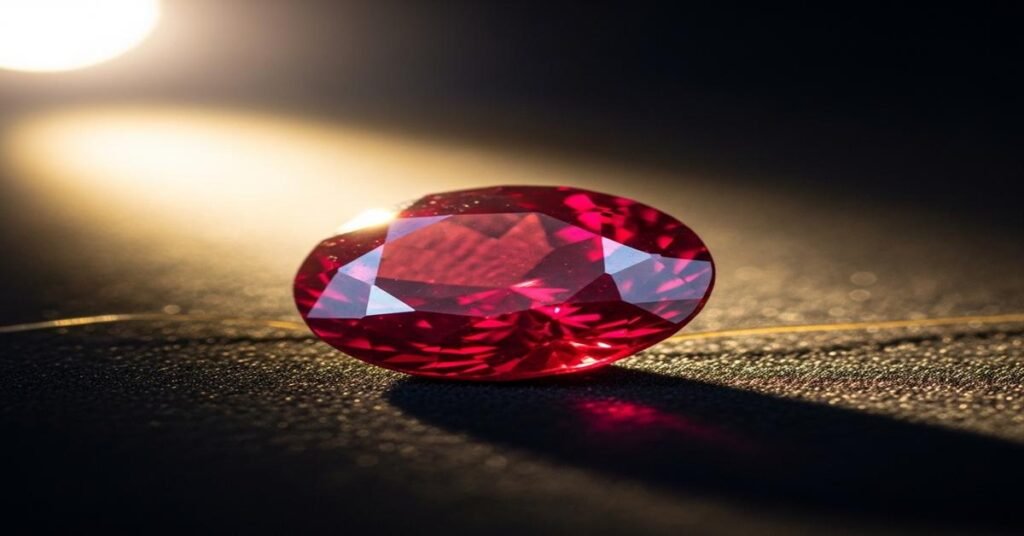Ruby, called Manik in Sanskrit, is the traditional gem for strengthening the Sun. People wear it seeking more authority, visibility and respect — the Sun governs status, leadership and public image in classical astrology. This article explains how ruby works, how to choose and set one properly, and three gemstones you should never wear with Manik unless a qualified astrologer has explicitly advised the mix.
Why ruby strengthens the Sun — the practical and astrological reasons
On a practical level a natural ruby’s deep red color and high refractive index make it look authoritative. That visual prominence helps the wearer project confidence. Astrologically, Manik represents the Sun, which stands for rulership, ego, career visibility and paternal figures. When the Sun in a natal chart needs support, a well-chosen ruby is prescribed to amplify those themes.
The ruby’s effect comes from three things: the gem’s optical presence (color and fire), a correct minimum weight and a proper metal setting (traditionally gold). If any of those elements are wrong — too small, poor color, or set in an inappropriate metal — the gem will not deliver the expected results.
How to choose a Manik: carat, size, color and setting
Minimum effective size: for most people, a ruby should be at least 1.0 carat to act as a primary planetary gem. Better results are commonly seen in the 1.5–3.0 ct range. As a rule of thumb, a 1 ct round brilliant ruby measures about 6.5 mm, 2 ct ≈ 8.0 mm, and 3 ct ≈ 9.5–10 mm. Below 1 ct, the stone becomes more suitable as an accent rather than the main talisman.
Color and clarity: choose a strong, pigeon-blood to deep purplish-red for best presence. Minor silk-like inclusions are acceptable; they do not negate astrological effect. Avoid heavily filled rubies or dyed composites. Heat treatment is common and acceptable if honestly disclosed. Glass-filled or composite rubies should be avoided for astrological use.
Cut and setting: faceted ovals, cushions or round brilliants concentrate color and sparkle. A well-cut stone shows even color across the table and crown. For setting, use yellow gold — 22k (≈91.6% Au) or 18k (≈75% Au) — in a secure four-prong or bezel mount. Gold is recommended because it harmonizes with the Sun’s “warm” symbolism. Avoid thin plated settings or soft metal that will not protect the stone.
Three gemstones strictly forbidden with Manik — and why
If you wear Manik to strengthen the Sun, do not pair it with these three gemstones on the same hand, same finger, or as adjacent talismans. Mixing them can blunt the Sun’s positive results or create conflicting energies.
-
Blue sapphire (Neelam — Saturn)
Why forbidden: Saturn is traditionally inimical to the Sun in many classical systems. Saturn’s restrictive, delaying energy opposes the Sun’s desire to be seen and recognized. Wearing a powerful blue sapphire (typically 1–3 ct or more) alongside ruby can create tension between acceleration (Sun) and obstruction (Saturn). Practically, both stones are intense and can pull attention in opposite directions, reducing clear benefits. If both are genuinely needed, a skilled astrologer will plan timing and separation rather than simultaneous wear. -
Hessonite (Gomed — Rahu)
Why forbidden: Rahu (shadow planet) brings obsession, amplification and unpredictability. Hessonite’s energy can amplify restlessness and create fame that is chaotic or unstable. Because the Sun seeks ordered authority, mixing Rahu’s stone may produce attention without stable respect. Hessonite is usually advised only when Rahu is strongly and positively placed and never simultaneously with ruby unless a chart-based prescription exists. -
Cat’s eye (Lehsunia — Ketu)
Why forbidden: Ketu is the planet of detachment, spiritual dissolution and loss of ego. Cat’s eye strengthens Ketu’s influence. Wearing it with a ruby, which strengthens ego, leadership and worldly status, creates an internal contradiction. The result can be mixed outcomes — sudden detachment, loss of clear authority, or split fortunes. As with the others, a specialist may recommend staged wearing, but not concurrent use by default.
Practical rules and exceptions
– Do not wear more than one major planetary gem (each >1 ct) on the same hand without professional guidance. Minor accent stones under 0.25 ct dispersed as small melee are less likely to cause conflict, but still consult your adviser.
– Place ruby in a ring on the ring finger of the right hand and wear it on Sunday after purification (common traditional practice). For women, customs can vary; use the dominant or prescribed hand per your adviser.
– Metal: use 22k or 18k yellow gold. Composition examples: 18k gold ≈ 75% Au + 25% alloy (typically copper/silver); 22k ≈ 91.6% Au + 8.4% alloy. Avoid silver or heavily rhodium-plated white gold as first preference for Manik.
Exceptions: If an experienced astrologer has chart-specific reasons, they may recommend combinations or temporal rules (wear ruby for a fixed period, then switch to another gem). Always follow a chart-based prescription when available. Never self-prescribe multiple strong planetary gems at once.
How to verify and care for your ruby
Buy from a reputable dealer who provides a gem report identifying treatments and origin. Ask specifically if the stone is glass-filled or composite — those are not suitable for astrological talismans. For daily wear, rubies are durable (Mohs 9) but should still be checked for chips or loosening prongs. Clean with warm soapy water and a soft brush. Have the mount checked annually.
Summary: A correctly chosen and set ruby can support Sun-related goals like visibility and respect. But do not mix Manik with blue sapphire, hessonite or cat’s eye without a professional chart-based plan. Those three stones carry planetary energies that conflict with the Sun’s aims and can produce confusion, delays or detachment instead of steady fame.
I am G S Sachin, a gemologist with a Diploma in Polished Diamond Grading from KGK Academy, Jaipur. I love writing about jewelry, gems, and diamonds, and I share simple, honest reviews and easy buying tips on JewellersReviews.com to help you choose pieces you’ll love with confidence.

